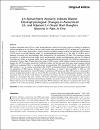L5 Spinal Nerve Axotomy Induces Distinct Electrophysiological Changes in Axotomized L5- and Adjacent L4-Dorsal Root Ganglion Neurons in Rats .
| Author | Djouhri, Laiche |
| Author | Zeidan, Asad |
| Author | Alzoghaibi, Mohammad |
| Author | Al Otaibi, Mohammad F |
| Author | Abd El-Aleem, Seham A |
| Available date | 2020-12-01T05:48:12Z |
| Publication Date | 2020-10-01 |
| Publication Name | Journal of Neurotrauma |
| Identifier | http://dx.doi.org/10.1089/neu.2020.7264 |
| Citation | Laiche Djouhri, Asad Zeidan, Mohammad Alzoghaibi, Mohammad F. Al Otaibi, and Seham A. Abd El-Aleem.Journal of Neurotrauma.ahead of print, http://doi.org/10.1089/neu.2020.7264 |
| ISSN | 0897-7151 |
| Abstract | Peripheral neuropathic pain (PNP) is a major health problem for which effective drug treatment is lacking. Its underlying neuronal mechanisms are still illusive, but pre-clinical studies using animal models of PNP including the L5-spinal nerve axotomy (L5-SNA) model, suggest that it is partly caused by excitability changes in dorsal root ganglion (DRG) neurons. L5-SNA results in two DRG neuronal groups: (1) axotomized/damaged neurons in L5- plus some in L4-DRGs, and (2) ipsilateral L4-neurons with intact/uninjured fibers intermingling with degenerating L5-fibers. The axotomized neurons are deprived of peripherally derived trophic factors and degenerate causing neuroinflammation, whereas the uninjured L4-neuorns are subject to increased trophic factors and neuroinflammation associated with Wallerian degeneration of axotomized L5-nerve fibers. Whether these two groups of DRG neurons exhibit similar or distinct electrophysiological changes after L5-SNA remains unresolved. Conflicting evidence for this may result from some studies assuming that all L4-fibers are undamaged. Here, we recorded somatic action potentials (APs) intracellularly from C- and A-fiber L4/L5 DRG neurons to examine our hypothesis that L5-SNA would induce distinct electrophysiological changes in the two populations of DRG neurons. Consistent with this hypothesis, we found (7 days post-SNA), in SNA rats with established pain hypersensitivity, slower AP kinetics in axotomized L5-neurons and faster AP kinetics in L4-nociceptive neurons including decreased rise time in Aδ-and Aβ-fiber nociceptors, and after-hyperpolarization duration in Aβ-fiber nociceptors. We also found several changes in axotomized L5-neurons but not in L4-nociceptive neurons, and some changes in L4-nociceptive but not L5-neurons. The faster AP kinetics (decreased refractory period) in L4-nociceptive neurons that are consistent with their reported hyperexcitability may lead to repetitive firing and thus provide enhanced afferent input necessary for initiating and/or maintaining PNP development. The changes in axotomized L5-neurons may contribute to the central mechanisms of PNP via enhanced neurotransmitter release in the central nervous system (CNS). |
| Language | en |
| Publisher | Mary Ann Liebert |
| Subject | axotomy neuropathic pain nociception partial nerve injury primary sensory neurons uninjured fibers |
| Type | Article |
| Pagination | 1-12 |
| ESSN | 1557-9042 |
Files in this item
This item appears in the following Collection(s)
-
Medicine Research [1309 items ]


